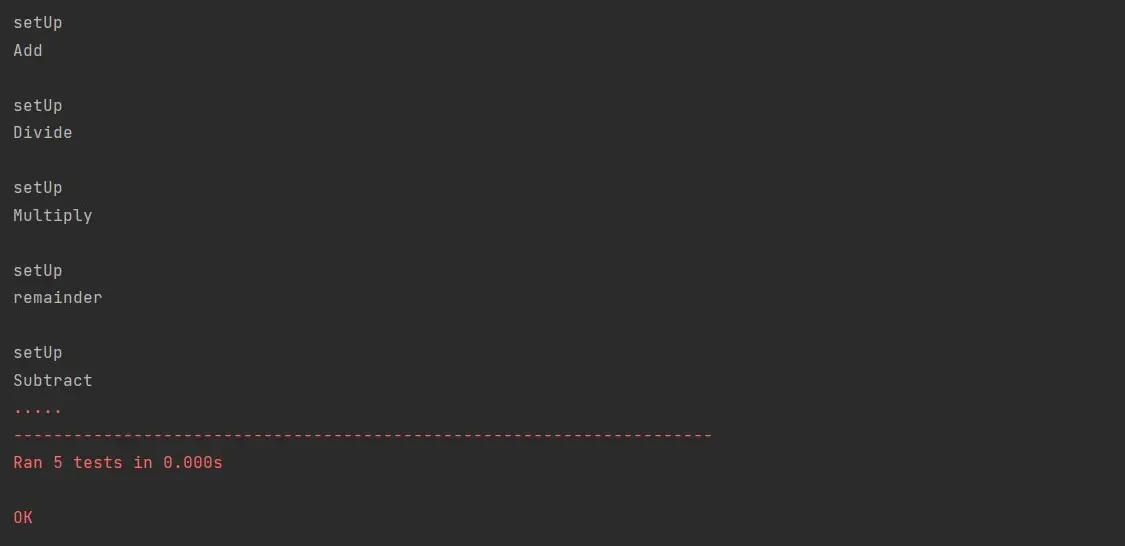How to Setup Python Unittest

Unit testing checks whether a particular code unit or a module performs as the developer expected. Most of the time, the unit of code we test is a function.
Likewise, we can test all the functions. As a best practice, at least in the development process, we should perform unit tests.
So, in the early stage of the development process, it detects bugs, and we can fix them without spending much time. If we skip these tests, it will be hard to fix the errors when continuing with the project.
Python unittest Setup
Python provides a different framework for unit testing called unittest. The unittest framework offers a few features.
The tests we perform using this method are independent of each other. In other words, the success, or the failure of a test, does not depend on other test results.
It also provides setup() and teardown() functions and test automation. The setup() function allows us to set the instructions to execute before each test method.
The teardown() function will describe the instructions running after each test method.
unittest gives us some essential concepts to use in unit testing, such as test fixture, test case, test suite, and test runner. This article discusses building a setup() function for unit testing using the unittest framework.
Create Functions to Test
First, we need to build some functions to test. Let’s create four functions to add, subtract, multiply, divide two numbers, and get the remainder.
def add(a, b):
return a + b
def subtract(a, b):
return a - b
def multiply(a, b):
return a * b
def divide(a, b):
return a / b
def remainder(a, b):
return a % b
We can test the above functions using the print() function, but it’s not very practical regarding hundreds or thousands of codes. So, let’s create a module to test the functions.
Create the Test Module
We should name our test module according to the naming convention. We use test_ as the first part of the name and then the module’s name.
Let’s create our test module for this tutorial as test_calc.py.
Naming convention:
test_ < name >
Then we have to import the unittest framework and numCal module to our test module. unittest includes it in the standard library, so we can directly import it. numCal is the module we need to test.
import unittest
import numCal
As the next step, we can create a class that inherits from unittest.TestCase so we will have access to more testing capabilities within that class.
class TestNumCal(unittest.TestCase):
Inside the class, we create methods for each function. We need to name the methods according to the naming convention when naming them.
When we run the test module, it will know which method represents the tests because the first part of the name is the test. Otherwise, it will not identify the test methods and skip them.
First, let’s create a test method for add() function.
def test_add(self):
self.assertEqual(numCal.add(10, 5), 15)
As in every method, self is the first argument of the test_add() method. We’ve used the assertEqual() method in the second line.
Since our TestNumCal class inherits from unittest.TestCase, we can access all the available assert methods. Methods such as assertEqual(), assertNotEqual(), assertTrue(), assertFalse() and assertIn() can be used in unit testing and there are lot more.
The assertEqual() method checks the equality between the value that returns from the function and the value we expect.
Then we need to set the test module to run directly from the editor. Otherwise, it will not run when we try to execute the test module.
So, for that, we can use the below code.
if __name__ == "__main__":
unittest.main()
Now our code should look like this.
import unittest
import numCal
class TestNumCal(unittest.TestCase):
def test_add(self):
self.assertEqual(numCal.add(10, 5), 15)
if __name__ == "__main__":
unittest.main()
Now we can test the add() function by running the test_calc.py module.
Output:

Here, the dot indicates that the test passed. If the test fails, F will appear, and if there is an error, an error message will occur.
Below, the dot shows how many units were tested.
Now let’s create four more test methods to test the remaining functions.
import unittest
import numCal
class TestNumCal(unittest.TestCase):
def test_add(self):
self.assertEqual(numCal.add(10, 5), 15)
def test_subtract(self):
self.assertEqual(numCal.subtract(10, 5), 5)
def test_multiply(self):
self.assertEqual(numCal.multiply(10, 5), 50)
def test_divide(self):
self.assertEqual(numCal.divide(10, 5), 2)
def test_remainder(self):
self.assertEqual(numCal.remainder(10, 5), 0)
if __name__ == "__main__":
unittest.main()
According to each function, we should change the test method name.
Output:

The hard part here is the value for each function needs to be set in each test method. It will be a problem when we have hundreds of test methods.
If the values need to be changed, we must review each test method and change them.
We can build the setup() function to overcome this. Through this method, we only need to declare the values once. Then before each method, it executes.
Create setUp() Function
def setUp(self):
print("\nsetUp")
self.num1 = 10
self.num2 = 5
After setting up the setup() function, the arguments for the functions also need to be changed. First, let’s change the test_add method.
def test_add(self):
print("Add")
self.assertEqual(numCal.add(self.num1, self.num2), 15)
As mentioned above, we can make the changes to the remaining methods, and our complete code should look like the one below.
Full code:
import unittest
import numCal
class TestNumCal(unittest.TestCase):
def setUp(self):
print("\nsetUp")
self.num1 = 10
self.num2 = 5
def test_add(self):
print("Add")
self.assertEqual(numCal.add(self.num1, self.num2), 15)
def test_subtract(self):
print("Subtract")
self.assertEqual(numCal.subtract(self.num1, self.num2), 5)
def test_multiply(self):
print("Multiply")
self.assertEqual(numCal.multiply(self.num1, self.num2), 50)
def test_divide(self):
print("Divide")
self.assertEqual(numCal.divide(self.num1, self.num2), 2)
def test_remainder(self):
print("remainder")
self.assertEqual(numCal.remainder(self.num1, self.num2), 0)
if __name__ == "__main__":
unittest.main()
Output:

In the output, five dots indicate that the tests have passed and the number of tests that ran. Below it, the values have been set before each test; to identify that, we’ve put print() functions.
So before the test methods start, the setup() function executes the defined instructions, and the tests happen using them.
Conclusion
In this article, we’ve learned what unit testing and unittest framework are and how to build a test module. Most importantly, we learned how to use the setup() function to set some defined instructions to execute before each test method.
The setup() function comes in handy when there are many tests to run and when we need to change the values for the arguments.
Nimesha is a Full-stack Software Engineer for more than five years, he loves technology, as technology has the power to solve our many problems within just a minute. He have been contributing to various projects over the last 5+ years and working with almost all the so-called 03 tiers(DB, M-Tier, and Client). Recently, he has started working with DevOps technologies such as Azure administration, Kubernetes, Terraform automation, and Bash scripting as well.
